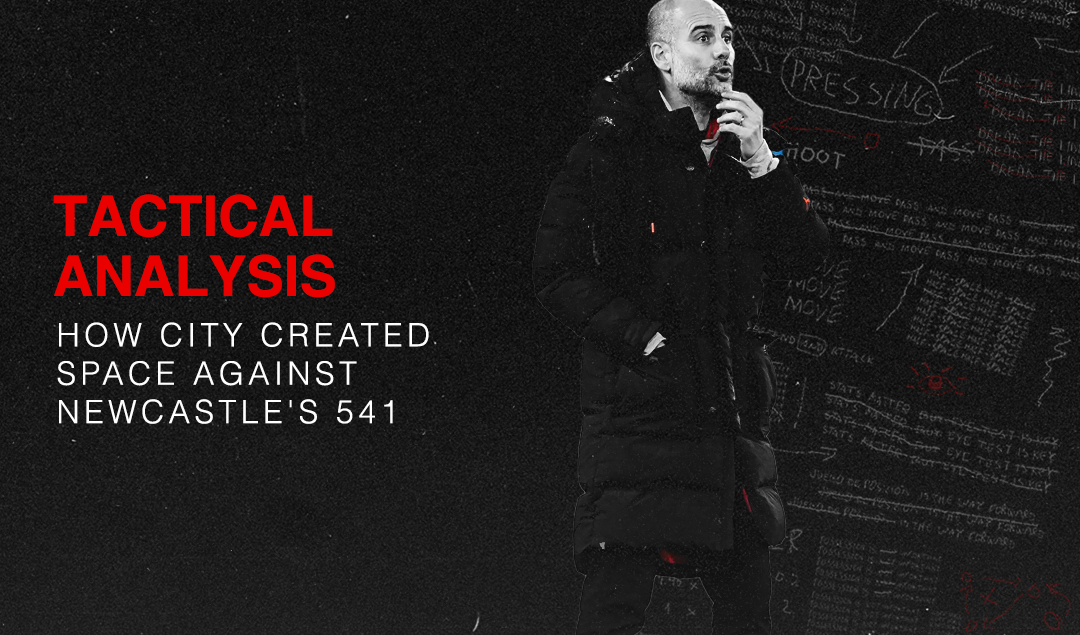How Manchester City Created Space Against Newcastle’s 5-4-1
Despite Manchester City’s success against low blocks since the arrival of Pep Guardiola in 2016, they have always struggled against the 5-4-1. When questioned by Gary Neville in August 2018 about whether or not Guardiola had been implementing new tactical ideas in pre-season training, he replied “Yes, we found a lot of problems to attack the 5-4-1, with the one, the striker, being with the holding midfielder, with 10 players so, so deep. We are thinking about how we will counter-attack that system.”
Evidently, Guardiola had identified that City were struggling to find solutions when attacking the 5-4-1. The quote implied that City’s struggles were originating from being unable to create space, considering the deep and compact nature of the shape.
The 5-4-1 defensive block is typically one of the most compact formations in football. From a defensive perspective, it provides excellent horizontal coverage along the defensive line allowing access to wide areas, whilst also possessing great box coverage which can help defend crosses. In addition, the shape also typically provides central compactness, therefore it limits space for the opposition in the final third.

Simply, football is a game of space. Offensively, it’s about moving the opposition to create space and finding the free man, defensively, it’s about protecting space and limiting the opposition to space in dangerous areas. Due to the lack of space afforded against a deep, compact 5-4-1 low block, Manchester City have often been unable to create a high volume of chances.
However, on Boxing Day 2020, this changed dramatically, as Manchester City welcomed Newcastle to the Etihad where a lesson was taught on how to create space vs the 5-4-1 low block. This article will analyse how they did it.
Role of Ferran Torres
Ferran Torres arrived at Manchester City in the summer of 2020 for an initial fee of £20.8 million. The Spain international became Guardiola’s first signing of the summer. Guardiola evidently sees Torres as a versatile attacker, having played him in all three positions across the front line this season. Despite being unable to break into the first team on a consistent basis, Torres has been largely effective when called upon.
The role that Torres played against Newcastle was vital to Manchester City’s performance. City lined up in their usual 3-2-5 during consolidated attacks, with Torres acting as the central focus, playing as the striker.

The aspect which stood out was the role of Torres within the 3-2-5. Typically, we see advanced midfielders on the same, if not, very similar horizontal lines to the centre-forward in consolidated attacks due to positional rotations and movements in an attempt to disorientate the opposition’s defence, however, in this case, Torres was deployed on the shoulder of the last Newcastle defender and was City’s most advanced player throughout the match.
The extremely high positioning of Torres essentially forced Newcastle’s defensive line to begin deeper, which therefore increased the amount of space between the lines. I believe this was the rationale behind Torres’ role. Vertically stretching an opponent, forcing them to cover a greater amount of space can open up space between the lines because the whole defensive shape cannot react to something which depends solely on the movement of the attacking team.
For example, the opposition’s midfield may be engaging and pressing close to the half-way line, unaware of space being created between the lines as a result of vertical stretching. Therefore, it is difficult for the team out of possession to react to this quickly on a consistent basis considering it is dependent on the opposition.

It is important to note that, where possible, there seemed to be emphasis on Torres occupying the defender on the same vertical line as Kevin De Bruyne. This was to ensure that the defender could not afford to step out and engage De Bruyne when he received possession between the lines because that would result in free space for Torres in behind.
Due to City’s excellent presence between the lines, other defenders could not step out or across because they were already occupied by a man. Therefore, this created space for De Bruyne predominantly to receive possession in free space, created by Torres.
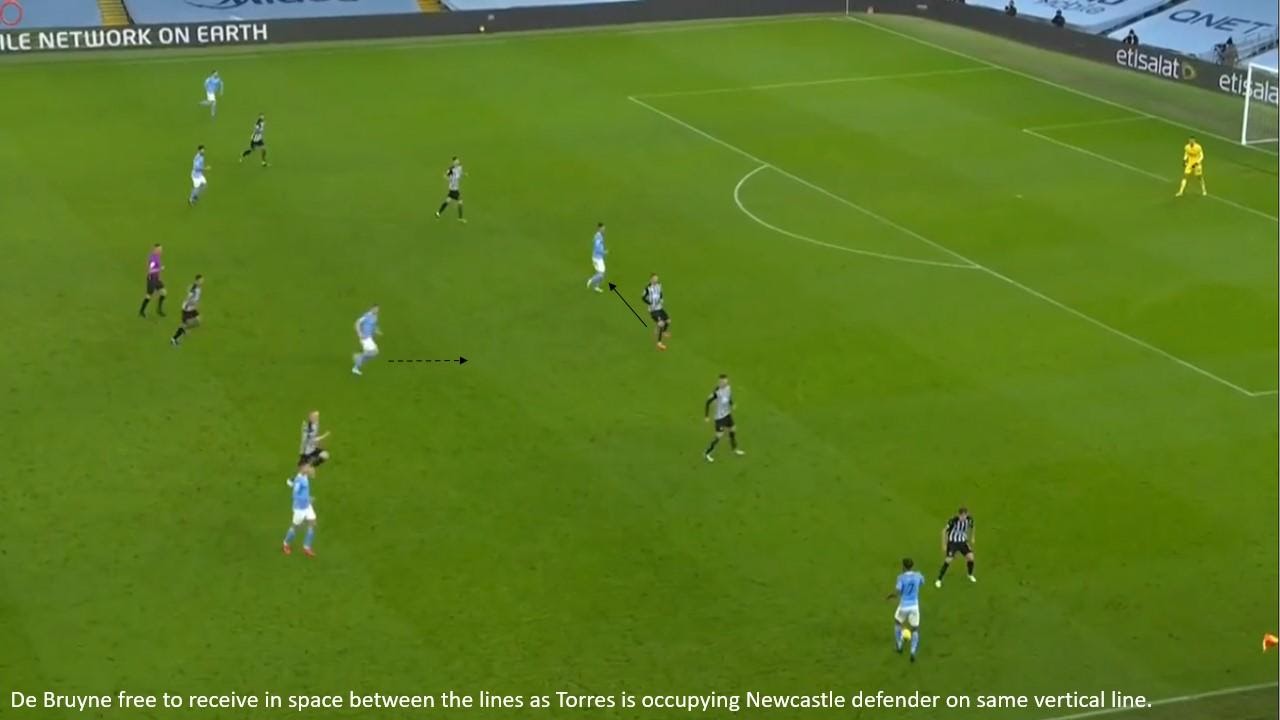
Not only did Torres begin higher, but his movement was also excellent, which was another important aspect of his performance. The Spaniard constantly looked to move in behind Newcastle’s defensive line when City had deep, stagnant possession around the half-way line.
This movement was extremely effective for two reasons; 1) he was often able to receive possession in behind Newcastle’s defensive line, exploiting the space between their defensive line and the goalkeeper, and 2) even if Torres did not receive the pass to match the run, he often dragged a defender with him, thereby stretching Newcastle’s defensive shape vertically.
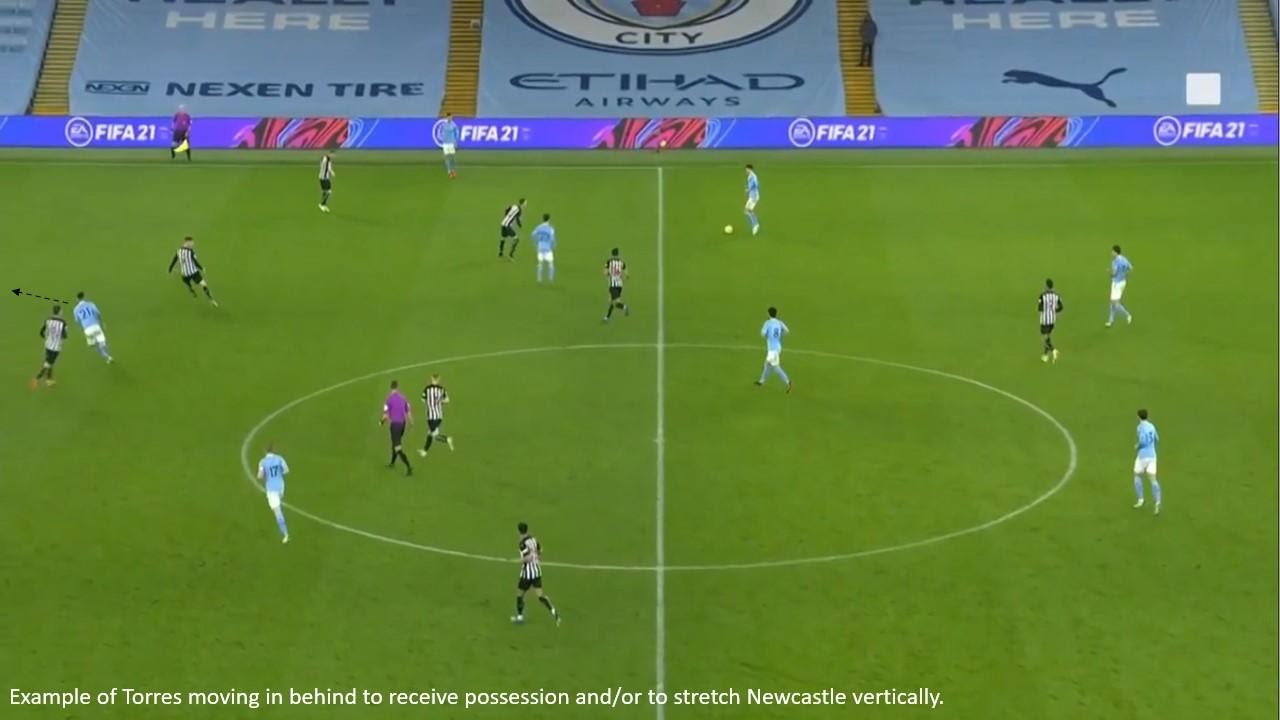
Generally in attack, it’s important to strike a balance between players who come to the ball to receive it, and players who move away from the ball to receive it. A balance of these two profiles within an attack can enhance the number of options the player in possession has, and it can also greatly impact the opposition’s defence.
If the attack was predominantly players who drop to receive the ball to feet, the opposition can step up, defend higher, engaging and pressuring them into mistakes, creating higher turnovers. This has been most prominent at Barcelona in recent seasons due to the lack of an attacker who will break forward and run in behind an opposition defence.
On the other hand, if the offensive team was predominantly players who moved away from the ball to receive, the opposition could drop off and protect space in behind, nullifying the threat that the attack had. Whereas a great mix of these two can stretch the opposition’s defence, disorientating their structure and therefore create space for attackers to either drop into or move into to receive the ball. The role of Torres in this match manifested the importance of striking a balance between these two profiles in offensive play.
Manchester City are not only skilled at finding players between the lines but having a constant presence between the lines, which is important in attacks because the space is dangerous and a high volume of chances are often created from this space. If the ball is progressed to a player between the lines, it often results in the opposition midfield now being ahead of the ball from a defensive perspective which is dangerous.
In conclusion, the advanced role of Torres helped create dangerous space between the lines via vertical stretching, thereby increasing the amount of space that the dangerous players between the lines had to receive the ball in. Torres capped off an excellent, selfless performance with a second-half goal, one that secured all three points for Manchester City.
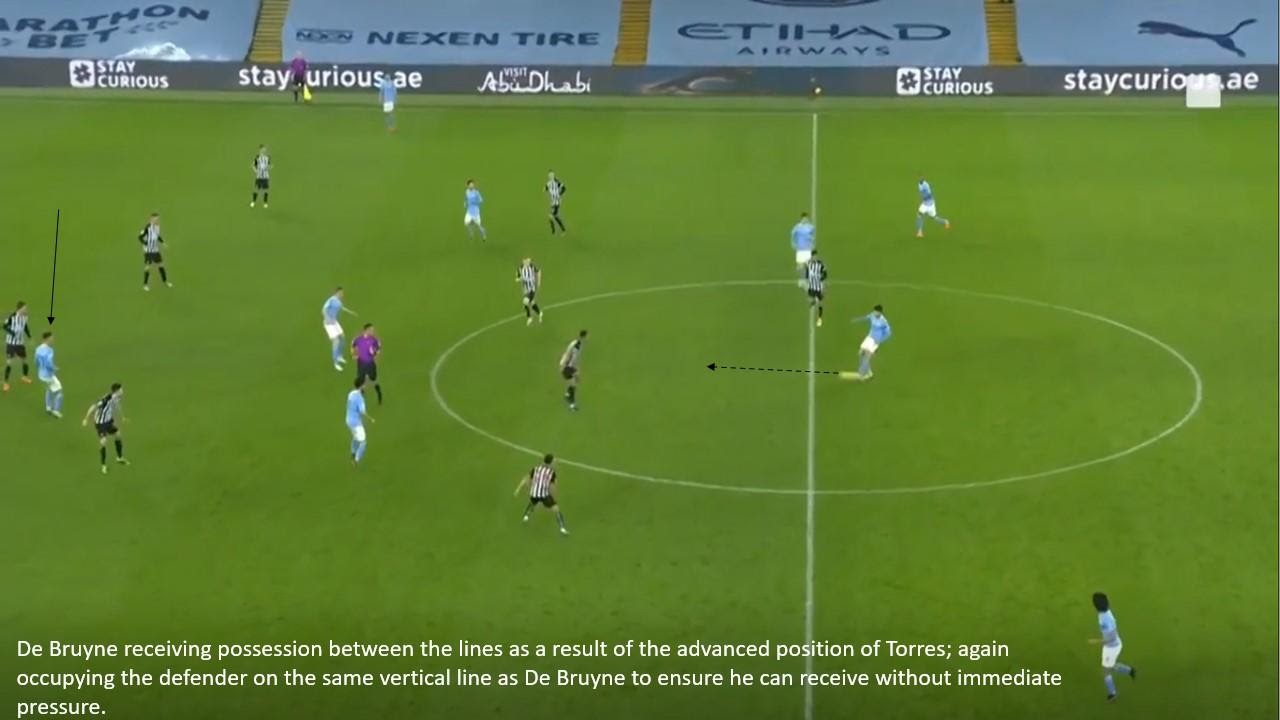
Overloading Zones and Finding the Free Man
Due to City’s shape in consolidated attacks, it is relatively easy to create overloads in specific zones without much positional rotation or movement to create the overload. This is due to the excellent presence between the lines that City boast, meaning that players are often positioned relatively close together in pockets of space, meaning that overloads can be achieved spontaneously without considerable movement. Against Newcastle, this was an important aspect of how they created space offensively.
These numerical overloads predominantly occurred in the left half-space, via İlkay Gündoğan and De Bruyne. The timing of the overloads seemed to be dependent on the positioning of João Cancelo. If Cancelo was positioned alongside Rodri during possession around the half-way line, De Bruyne would remain central, or even peel to the right of central focus Torres in an attempt to cover all five vertical lanes, however, when Cancelo advanced into a higher position, predominantly into the right half-space, this gave De Bruyne the licence to position himself in proximity with Gündoğan.
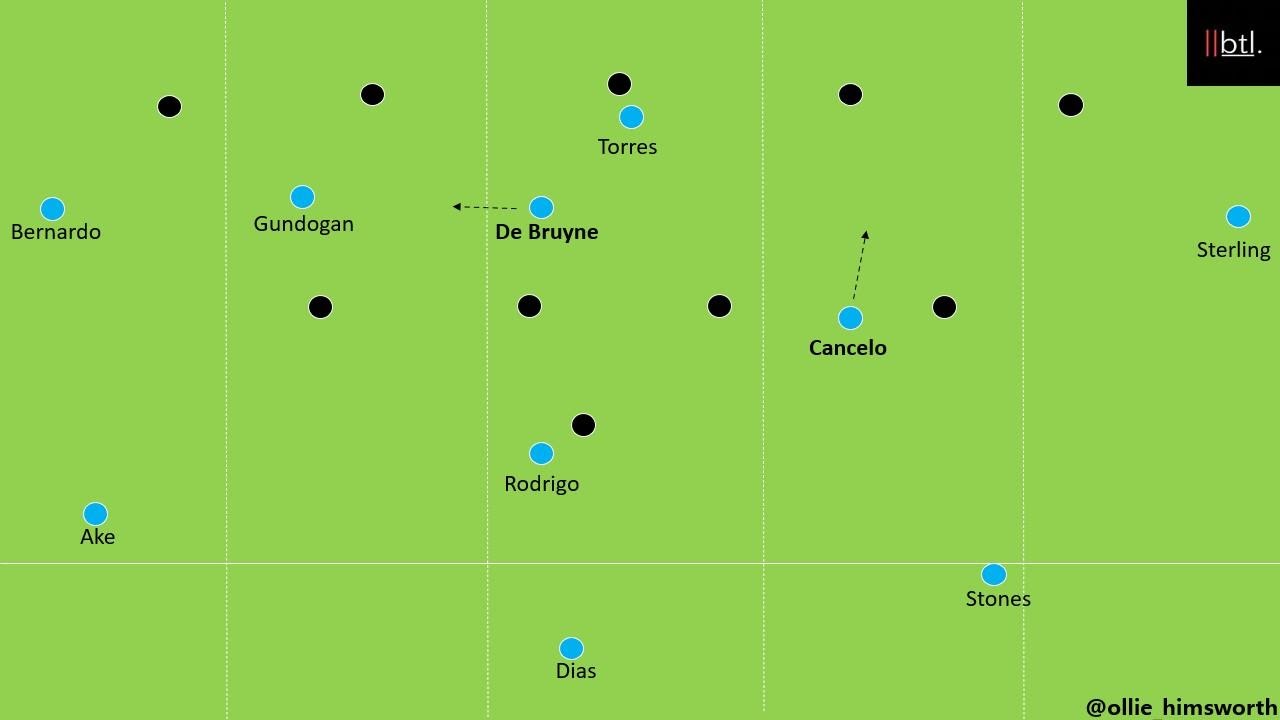
This movement essentially allowed City to create a 3v2 on the left side of the pitch, which impacted ball progression greatly. Overloading this zone allowed City to progress the ball from the second phase into the final third with relative ease, and it proved difficult for Newcastle to defend because it essentially created another passing lane, which was difficult to block due to the spontaneity of the movement.
As the timing of these overloads was mainly reliant on the position of Cancelo in the left half-spaces, the movement to create the overload was spontaneous and happened quickly, which proved difficult to react to from a defensive perspective because it would have required the midfield to shuttle across in very little time.
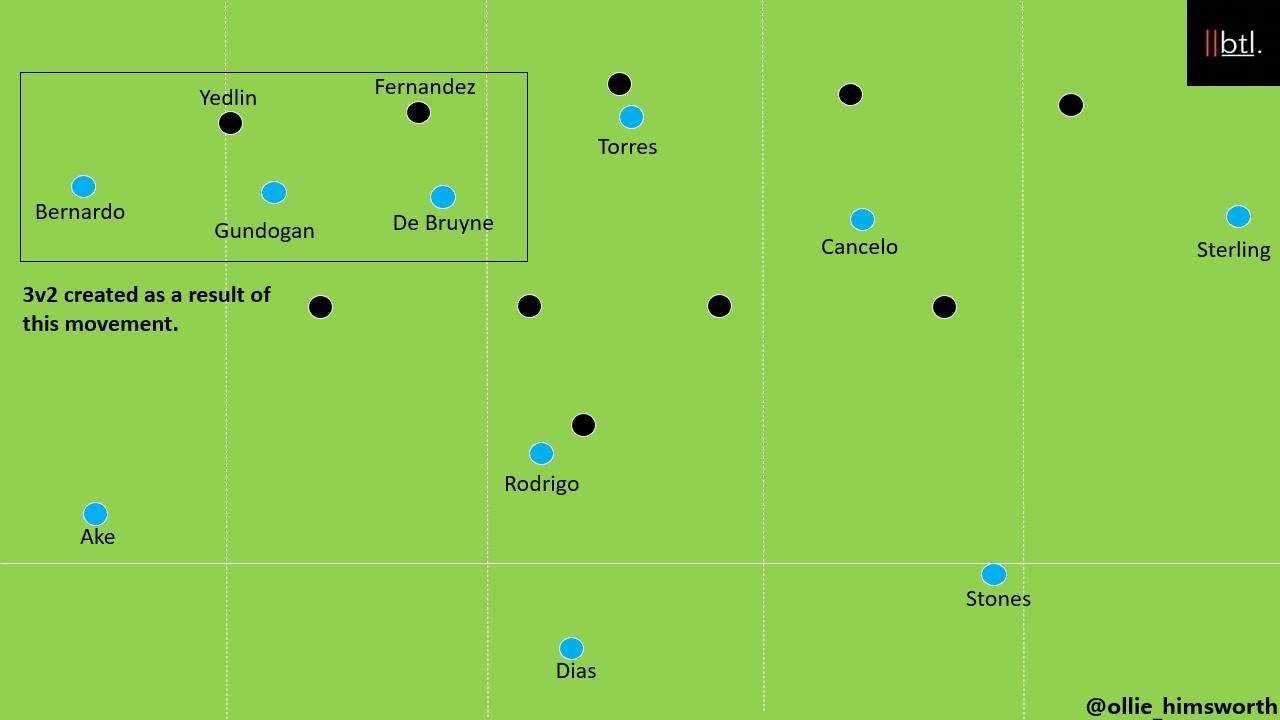
Due to the 3v2 overload, a predicament was created for DeAndre Yedlin and Federico Fernández, the two defenders within proximity of the overloaded zone. From City’s perspective, the platform for ball progression was created via the 3v2 on the left side of the pitch, however, how and who they progressed the ball to was largely dependent on the movement and positioning of Yedlin and Fernández.
It all boils down to finding the free man in the first and second phases of play in order to progress the ball, which is a fundamental principle when in possession. To progress the ball, City would simply circulate possession to the free, unmarked man created via the overload. This was typically Gündoğan; Fernández usually occupied De Bruyne, and Yedlin remained closer to Bernardo Silva which left the German free to receive possession in the half-space.
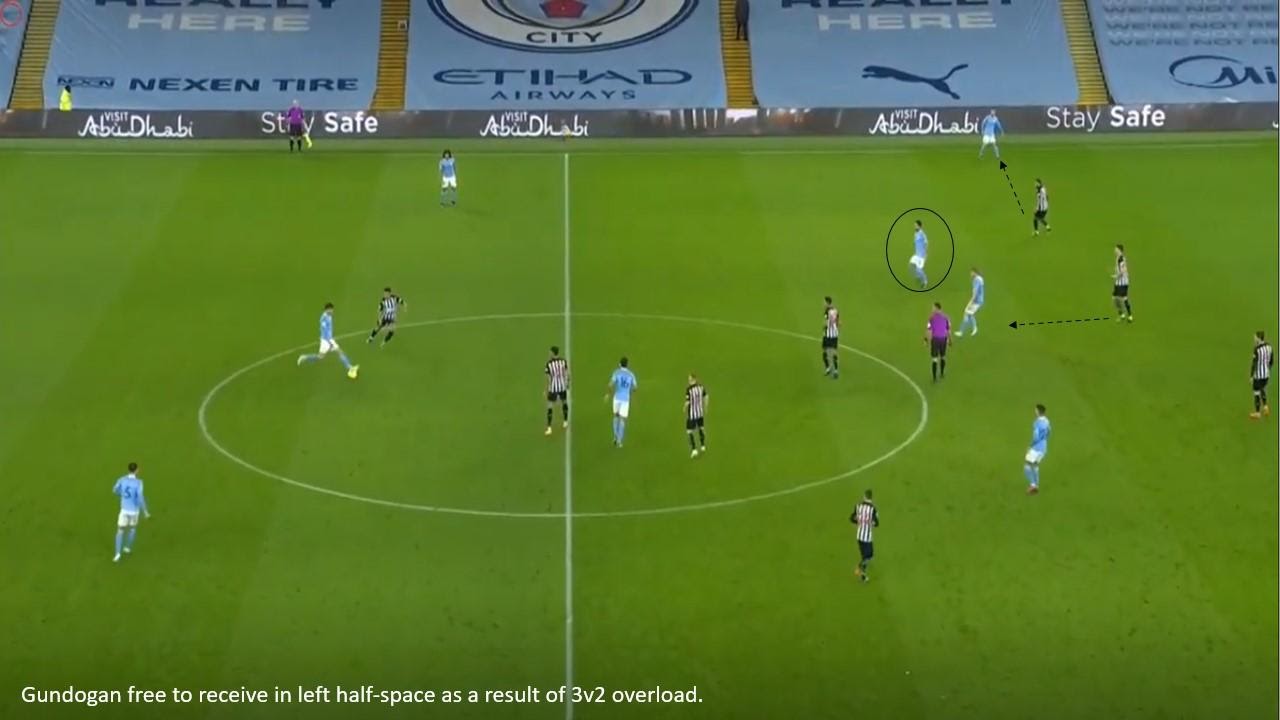
However, there were also examples when Bernardo was the free man on the left flank. The overload of the left half-space sometimes pinned Yedlin, the right wing-back, inside to mark one of Gündoğan or De Bruyne to ensure that they could not receive possession without immediate pressure.
However, this only led to the space being created elsewhere, i.e., on the left touchline where Bernardo was operating. This was exacerbated from Newcastle’s perspective due to the extremely wide positioning of Bernardo when Yedlin was pinned inside. This essentially increased the amount of space and time he had to receive possession once City found him.
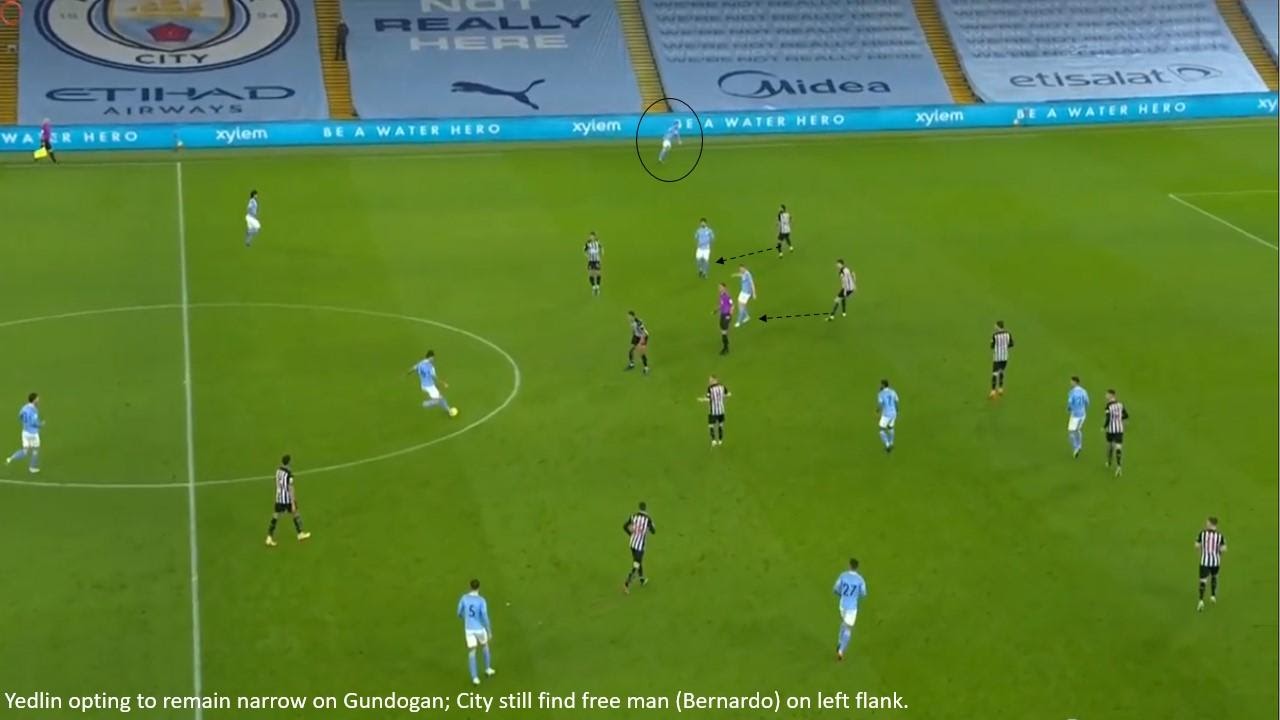
Manchester City were also able to utilise this following switches from right to left, and this was largely down to the confusing positioning of right-sided midfielder Jacob Murphy when City had possession on their right. Murphy was positioned relatively high, ready to press City’s backline in the case of the ball being recycled, rather than tucking in and providing midfield cover to minimise the impact that a quick switch of play may have on the far side.
The diagram below illustrates where Murphy was positioned when City had possession on the right, and where he should have been positioned in order to prevent a successful switch of play.
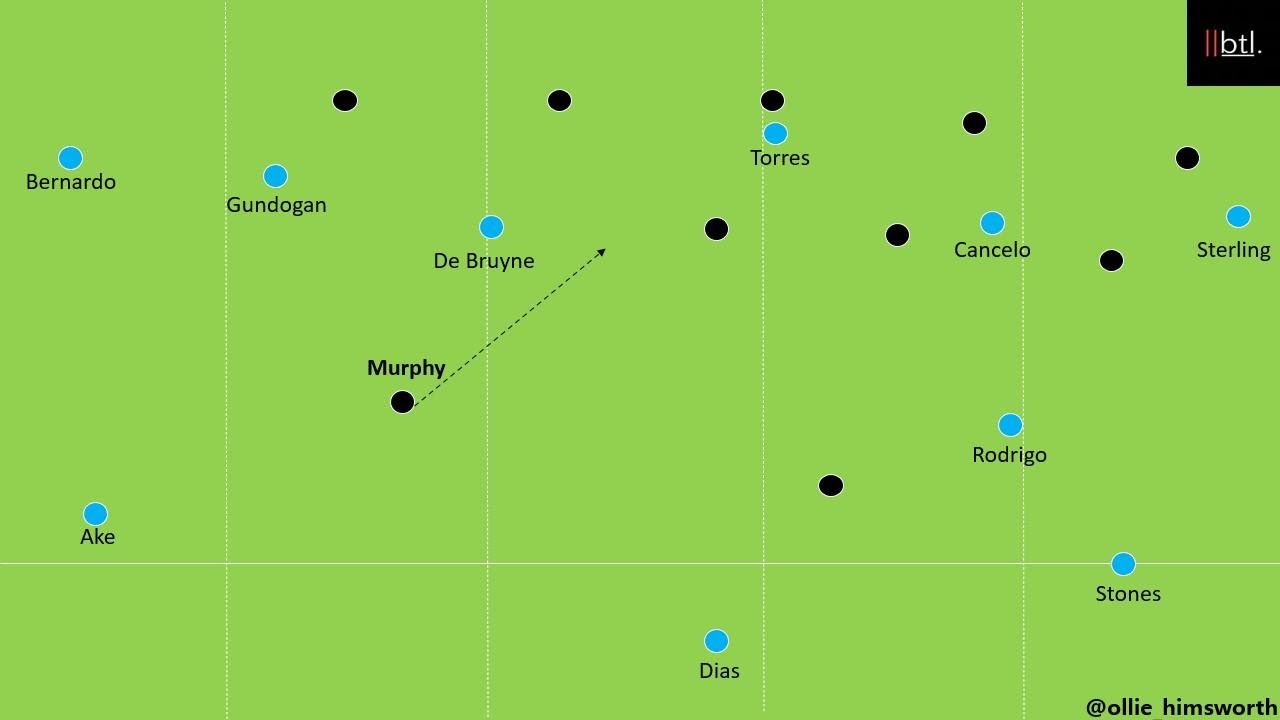
This left Newcastle extremely underloaded on the far side, as the midfield naturally shuttled across to the ball side to provide support to the wing-back. Therefore, this created a substantial gap within Newcastle’s defensive structure and allowed City to switch the play quickly, and crucially, gain territory on the opposite flank.
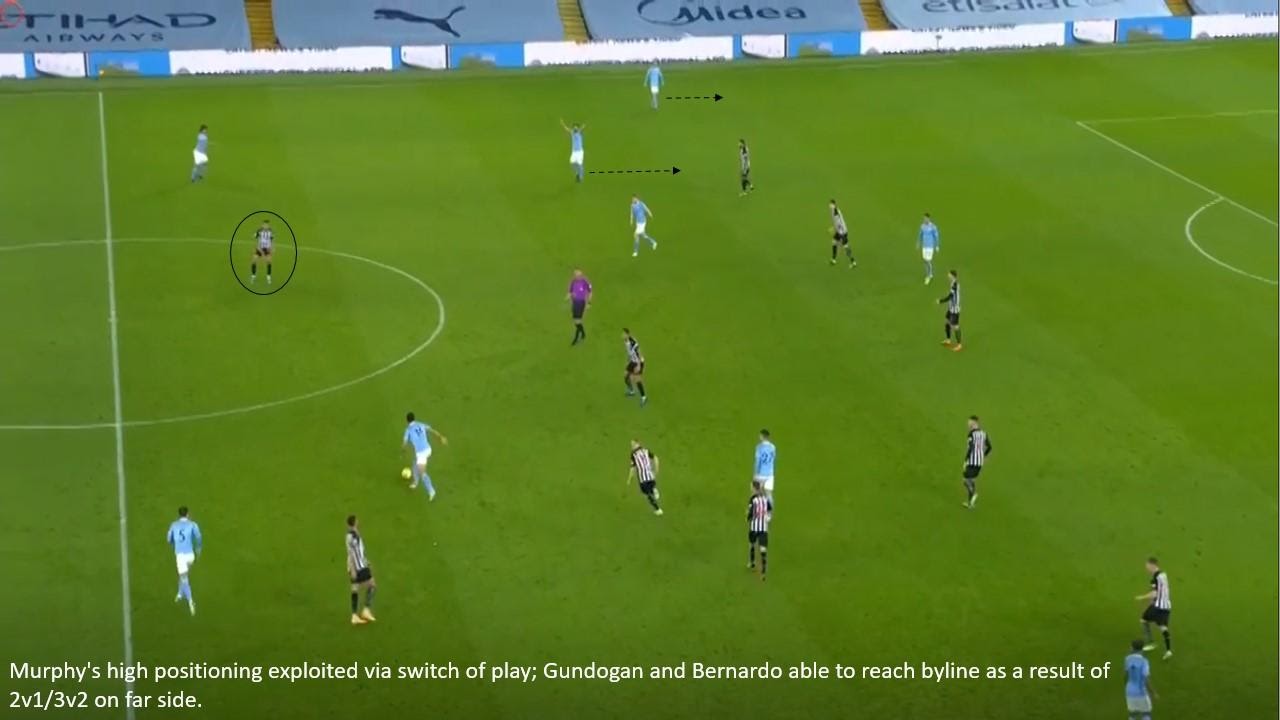
Deep Half-Space Infiltration – John Stones
Deep half-space infiltration is a common aspect of Manchester City’s play in possession. Against Newcastle, it was extremely evident following switches from left to right. This was typically manifested by John Stones stepping out of defence, in order to provide an outlet on the far side for City to switch possession instead of recycling it by going backwards.
When the ball was being switched, finding the player in the half-space, typically Stones, was fairly simple due to the commitment to the ball side that the Newcastle midfield had made out of possession. It can be exceedingly difficult to cover adequate space horizontally against Manchester City because they stretch the pitch exceptionally well which essentially forces the opponent into covering a greater amount of space.
Newcastle’s commitment to the ball side was understandable given the presence that City possess between the lines, however, there is always a trade-off against City. The commitment to the ball side was usually manifested by Miguel Almirón’s (left-sided midfielder) narrow position. City were able to switch frequently into Stones in the free half-space.
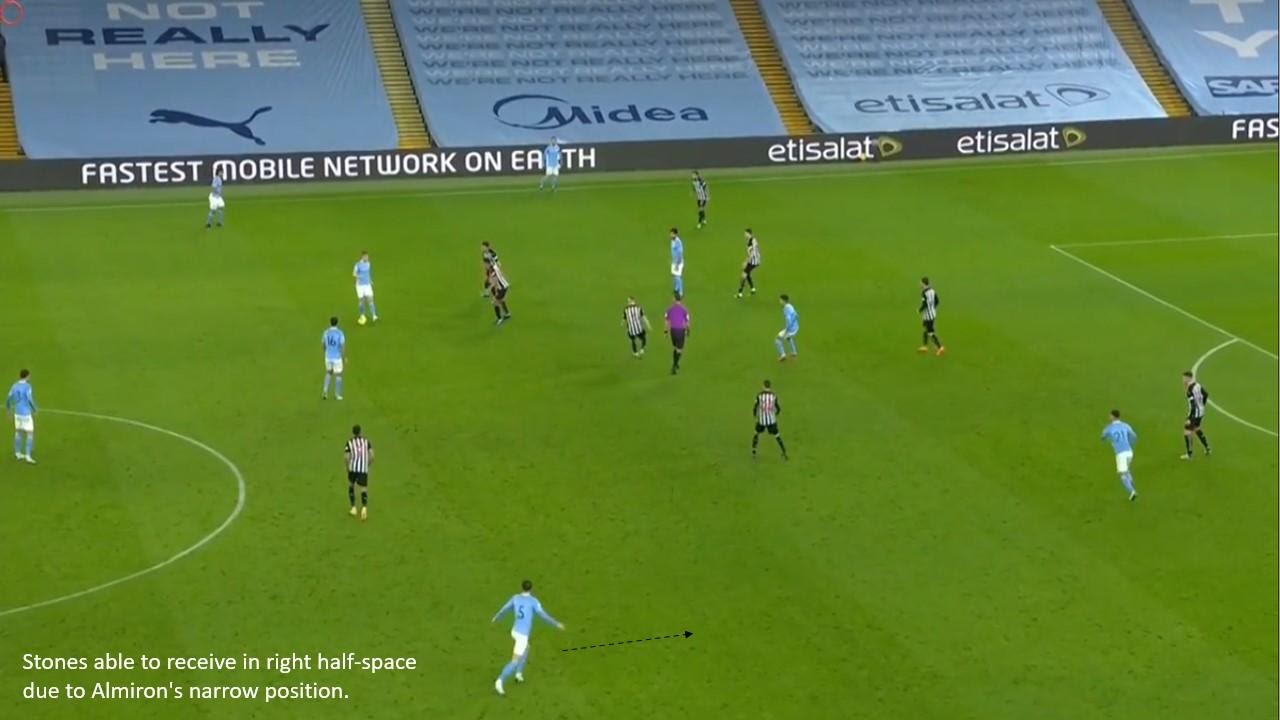
The deep half-space infiltration on the far side allowed City to attack down the left, committing numbers in the process, and switch the play to continue attacks when Newcastle nullified the space on the right. This fits in with the football cliche: build down one side to attack down the other. The role of Stones was pivotal here, as the license he was given to step up and join attacks consequently allowed City to sustain pressure.
This meant that when Newcastle nullified space on the right, City could switch to Stones to continue attacks, rather than passing backwards to Nathan Aké or Rúben Dias who were positioned deeper, which would have allowed Newcastle to shuttle across and regain coverage of space horizontally. City maximised this and were able to sustain attacks as a result of making the pass to Stones in a single pass, rather than two (i.e., first pass to Dias, second to Stones).
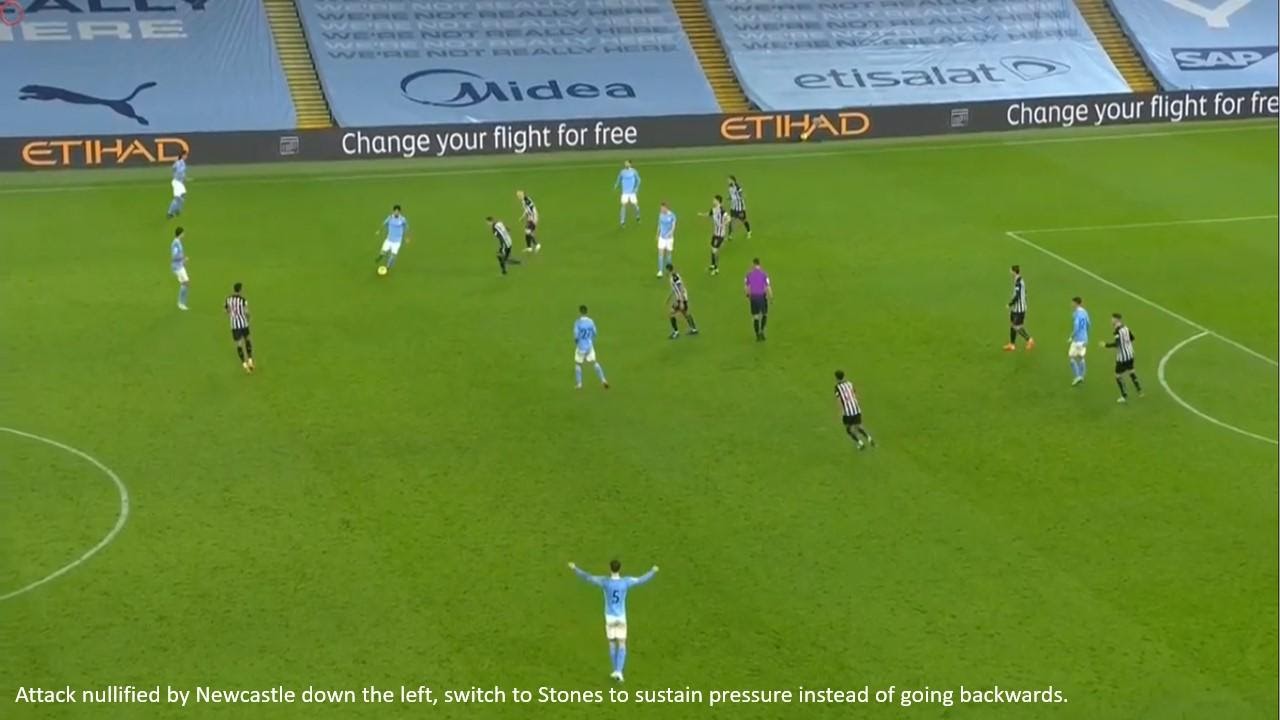
The greatest advantage of deep half-space infiltration, especially following switches, is that it allows you to gain territory. This is because as aforementioned, the space on the far side of midfield is often left open as the team without possession have shuttled across to support the ball side.
As such, the player who receives possession is often unchallenged and can carry the ball forward into the space ahead of him, allowing the team to gain territory and the attack to take place higher up the pitch. This often led to Stones carrying the ball into a higher position, which resulted in City gaining territory towards the penalty box.
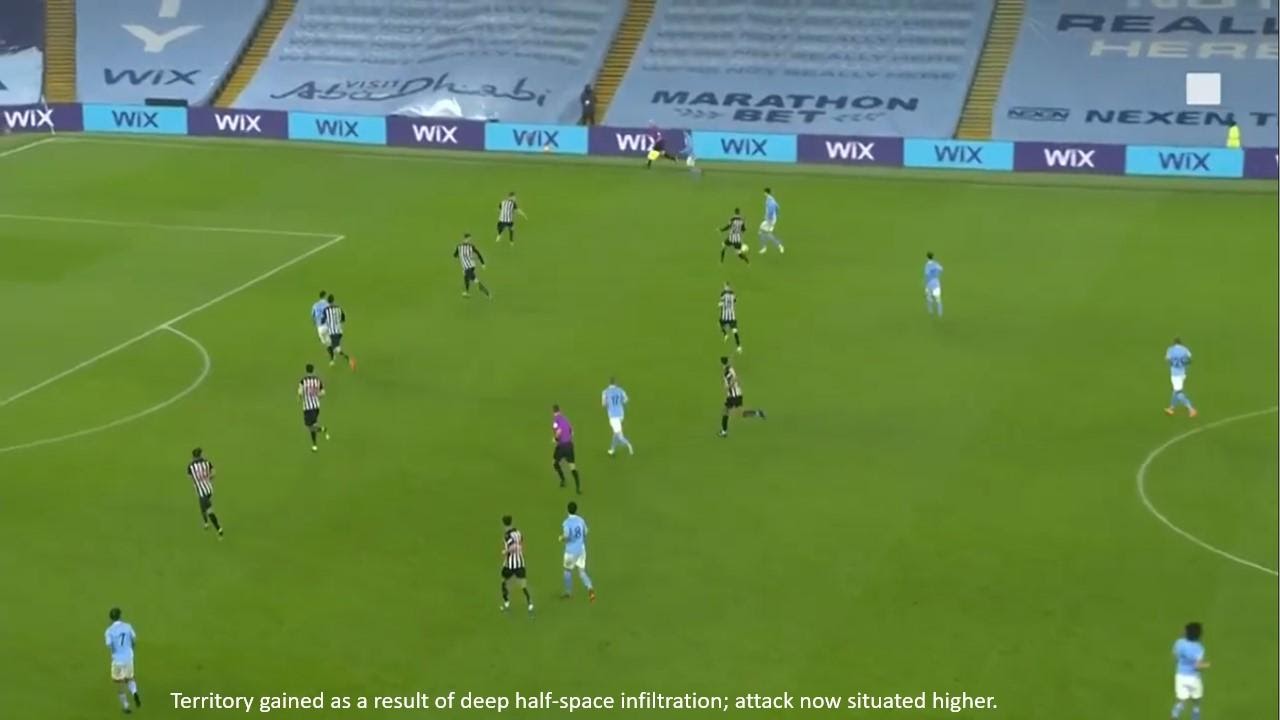
Not only did this allow Manchester City to gain territory, but it also had an impact on the opponent. Consistently switching the ball from one side to the other the opponent into shuttling across the pitch horizontally frequently; this proved to be challenging for Newcastle in this match. Once the ball had been switched to Stones, Newcastle would shuttle across to the ball side which would consequently leave space on the far side again.
City were able to exploit this by circulating the ball towards the free space and the free man in the final third, again gaining territory and causing attacks to be situated higher. This is the impact that deep half-space infiltration had on City; they were able to move Newcastle’s defensive shape and create space to attack by forcing them into shuttling to cover space constantly.
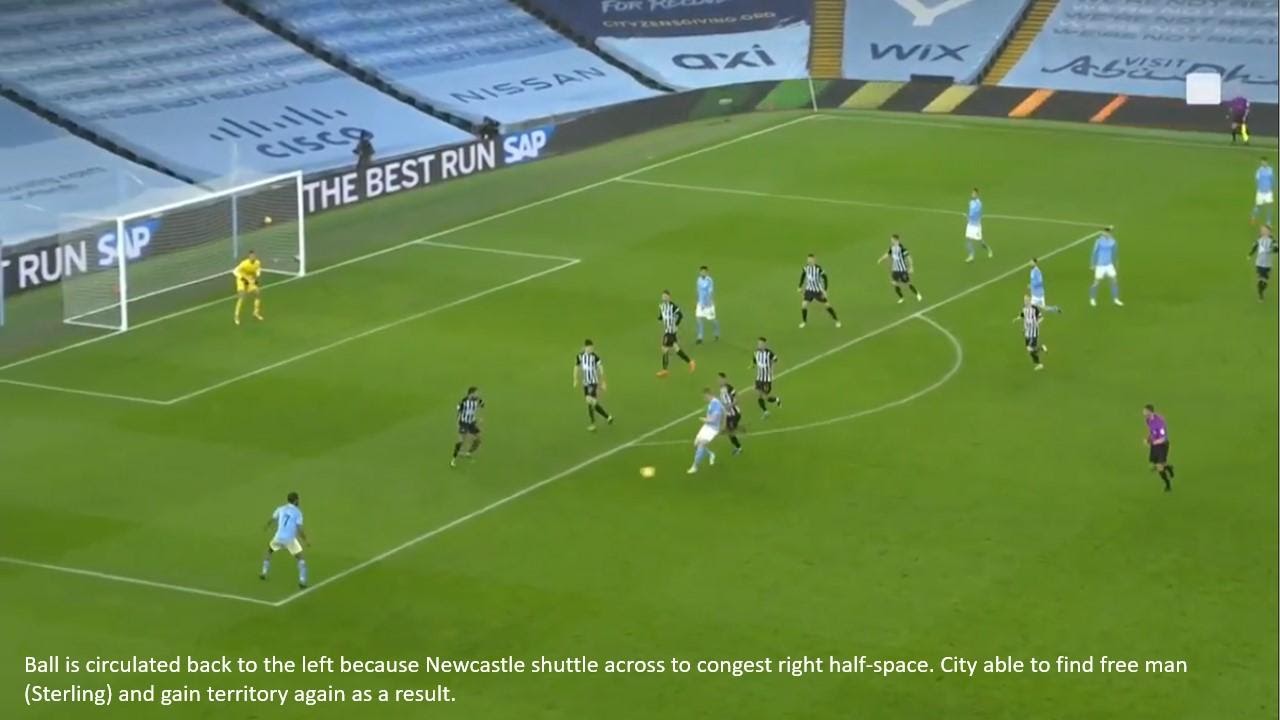
Perhaps the most important factor of deep half-space infiltration following switches is that it is carried out in a surreptitious manner, to prevent an opposition player from being able to apply immediate pressure when the player joining the attack receives possession.
It is naturally done surreptitiously because 1) it is on the far side and therefore can go unrealised as the opposition are committed to the ball side, and 2) it is naturally on the blindside of the midfield. This is important because it allows for the player in the half-space to receive possession without pressure which can result in a greater amount of territory being gained.
Conclusion
In conclusion, Manchester City were able to create space against Newcastle’s 5-4-1, something they have been unable to do in the past. The role of Ferran Torres proved vital and forced Newcastle’s defensive line to begin deeper, therefore creating a greater amount of space between the lines for Kevin De Bruyne and İlkay Gündoğan to operate in.
Overloading the left half-space to create a 3v2 gave Newcastle a great predicament and resulted in simple ball progression into dangerous zones of space between the lines. This was another way of circulating the ball to De Bruyne and Gündoğan, City’s most dangerous attackers.
Finally, deep half-space infiltration proved to be extremely effective following switches. This was manifested by John Stones stepping out of defence to provide an option on the right after Newcastle congested the space on the left. This allowed City to sustain attacks and gain territory via the half-spaces. Sustained pressure eventually paid off, as goals from Gündoğan and Torres completed a comfortable home win for Manchester City, in which they taught a lesson on how to create space against the 5-4-1 low block.
By: Ollie Himsworth
Featured Image: @GabFoligno / Matt McNulty – Manchester City
